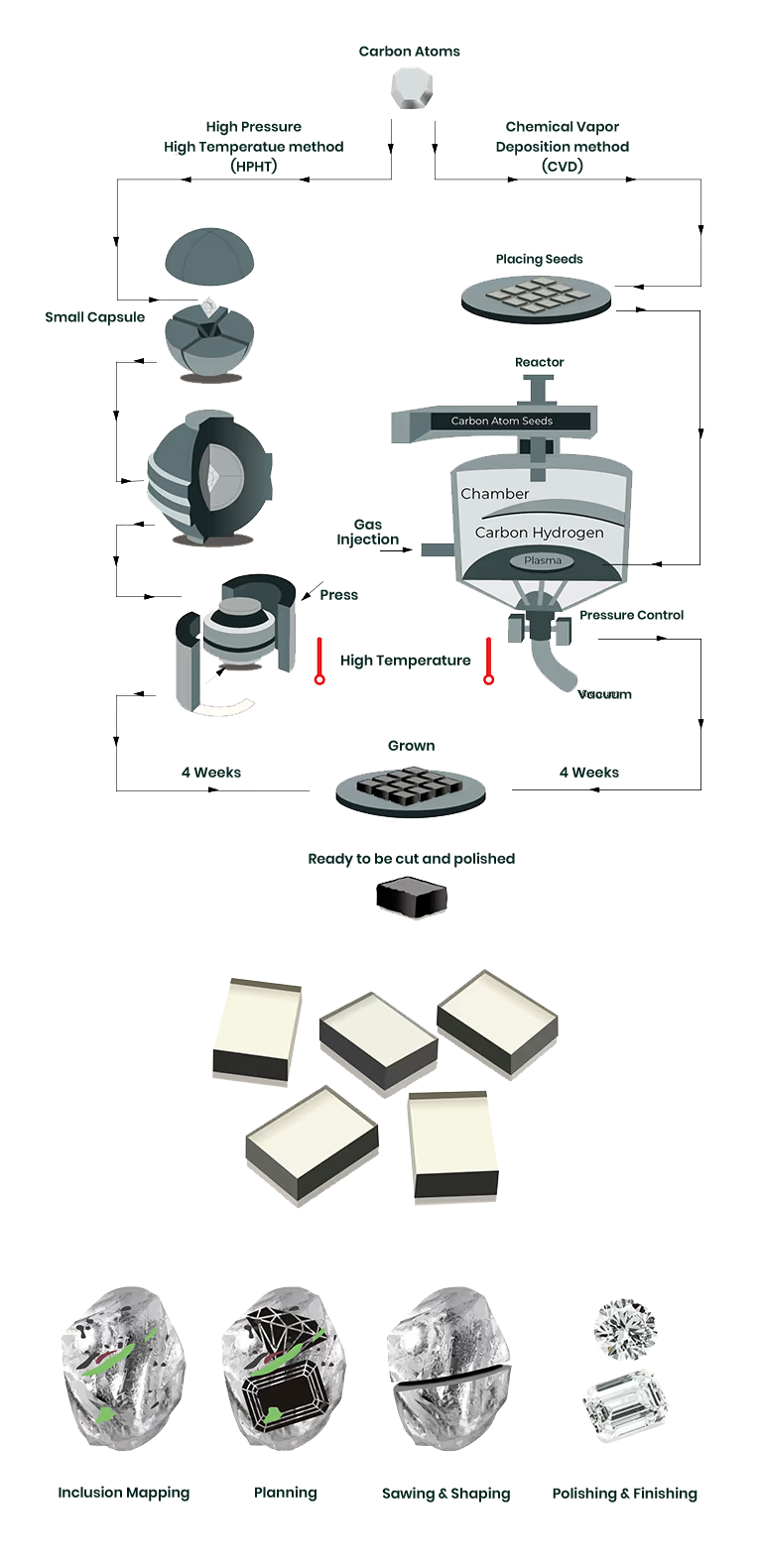
HOW ARE LAB GROWN DIAMONDS MADE?
Lab-created diamonds are made using one of two primary methods: High Pressure High Temperature (HPHT) or Chemical Vapor Deposition (CVD).
Both methods produce diamonds with identical chemical and physical properties to natural diamonds, but they allow for more control over the process, resulting in diamonds with fewer impurities and more consistent quality.
Gleam Green lab grown diamonds are made using both the methods above, depending on the size and carat weight of the diamond required.

No, lab-grown diamonds are genuine diamonds with identical chemical composition to natural diamonds. The distinction lies in their origin; lab-grown diamonds are cultivated in controlled environments using advanced technology. They exhibit the same brilliance, hardness, and beauty as mined diamonds. Comparing them is akin to ice from your freezer versus ice from a glacier.
While they share the same chemical composition, only trained gemologists equipped with advanced tools can detect variances in their growth patterns and inclusions. Utilizing technology like UV fluorescence imaging and specific laser inscription patterns helps distinguish between them. However, to the unaided eye, it's nearly impossible to discern the dissimilarities.
Yes, they do. Diamond testers operate on thermal conductivity principles, and lab-grown diamonds share the same thermal properties as natural diamonds, yielding a positive test result. These sophisticated testers can differentiate between diamonds and other gemstones, confirming the authenticity of the stone. Whether mined or lab-grown, both types of diamonds will register a positive outcome on a trustworthy diamond tester, providing reassurance to consumers and jewelers regarding the diamond's authenticity.
The best lab diamonds are high quality, sustainable, and backed by third-party verifications. There are many
types of lab diamonds on the market that do not measure up in quality or ethics.
High Quality: Type lla diamond, grown using CVD technology and untouched by any post-treatment, finished with
an exceptional cut. Learn more about the best lab grown diamonds.
Sustainability: Not all lab diamonds are sustainable. Make sure diamond is grown with renewable energy and or
carbon-capturing resources and gives back to mining communities.
Lab-grown diamonds, if grown slowly and are not post-treated, are as sparkly as their mined counterparts. Although all diamonds, whether lab or minded, share the same physical and chemical properties, some post-treatments can damage the internal structure of the diamond, causing them to be less sparkly. That is why it's paramount only to purchase high-quality lab-grown diamonds.
Lab-grown diamonds are graded based on the same 4 Cs and exhibit the same variations in color, clarity, and cut like their mined counterparts. However, Type lla diamonds from Gleam Green contain such a pure form of carbon they will appear brighter than the regular Type Ia. The same color grades in a Type la mined or lab diamond will look duller than a Type lla diamond in the same color grades.
Beyond sustainability, the highest quality lab diamond is a Type lla diamond grown using CVD technology and untouched by any post-treatment. This pioneering approach must be paired with an exacting cut to capture extraordinary light dispersion and sparkle—such diamonds merit evaluation against rigorous benchmarks like AGS or GCal 8x cut grading. At Gleam Green, this distinction is inherent, making our diamonds the highest quality – the top 1% of all diamonds.
Quality: Make sure your lab diamond is high quality with an exceptional cut.
Certification: Your lab-grown diamond must come with third-party verifications on technology and grading.
Sustainability: Grown with renewable energy resources and give back to mining communities.
On average, Gleam Green created diamonds are priced up to 50% less than an earth-mined diamond of equivalent quality. However, the price of a lab-grown diamond depends on various factors such as the 4 c’s - carat weight, cut, color, and clarity, just like mined diamonds. This affordability opens up a world of possibilities, allowing you to choose a larger or higher quality lab-grown diamond for your budget. So, if you're looking for exceptional value without compromising on beauty, lab-grown diamonds are an enticing and cost-effective choice.
The difference in price is because our supply chain is so much shorter. Earth-mined diamonds can travel to five countries and touch 20 hands before it reaches the end consumer. Gleam Green lab-created diamonds go from our labs to our casting house to you. Not only is it more efficient, but it’s also better for your wallet and the environment.
Yes, it's possible to get a much larger lab-grown diamond for the same price as a smaller natural diamond. This cost difference allows you to choose a larger lab-grown diamond with similar specifications for the price of a smaller natural diamond. However, consider that lab-grown diamonds offer the same brilliance, sparkle, and durability as natural diamonds, making them an attractive and budget-friendly alternative for those seeking a bigger stone without compromising on quality.
Colored lab diamonds are crafted through controlled processes mimicking natural diamond formation. By introducing specific trace elements during growth, lab-grown diamonds acquire various hues. Boron results in blue shades, while nitrogen leads to yellows and oranges. Radiation exposure can create green and pink tones. Learn more about colored lab created diamonds.
Yes! But you have to consider the quality of your lab diamond just like you would an earth-mined diamond. Post treatments in lab-grown diamonds or natural diamonds will lower the value. Not having a reputable USA grading certificate will also lower the value of your diamond.



